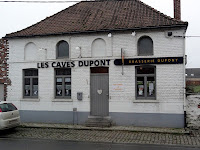But I'm getting ahead of myself. Les Caves is a side project of Nick's that is meant to evoke the cafes of Belgium and serve as a less family-friendly alternative to Block 15, which is immediately next door (one day a door may join them). Key fact: Nick is besotted with Belgium. References to his travels there are scattered around (Wandelpad, the Provision saison), and for anyone with the good fortune to have visited Tourpes, Les Caves is instantly familiar:
The inside of the wood-paneled, shotgun pub has evocative photos of Belgium on the walls, and the food and tap list are further evocations. It's not a theme pub, though, so while you find mussels and frites and the house saison on the menu, you also find IPAs and lamb ragu. (It strikes me as perfectly Belgian to have local specialties on the menu with the classics.) I can't speak for the food, for I had just come from a feast at Flat Tail. The Caves Saison, however, was great.
Only a couple beers are Block 15's; the rest are given to Oregon and European beers. The two Block 15 beers, though, can only be found in the Caves. One's an IPA and one is a specially-made saison. Nick started with a farmhouse strain and open-ferments the beer, top cropping for future batches; his hope is to let that strain pick up house characteristics. He then adds a portion of barrel-aged saison that has wild yeasts (read the full procedure here). It's a dry, spicy beer, but beyond that I would say go try it yourself--the brewery is currently on batch 3, but this beer is mid-evolution and batch 4 won't taste the same.
Spontaneous Fermentation
Block 15 has had a coolship in the cellar underneath his brewery for a long time--he had it when I visited in 2010. Built deep so it could handle both spontaneous inoculation--filled shallowly--and also regular open fermentation. But since the coolship is in the basement, and since coolships are normally on the top floor of a brewery, Nick has been trying to inoculate the room with wild yeasts. There are barrels down there, and he knows that spills and sloshes release the buggies inside (exactly why breweries do their best to sequester brettanomyces--when they use it at all). In January, he felt the time was right to try a batch of spontaneously-fermented beer. He has done everything he can to adhere to the standards of lambic-brewing: a turbid mash (he uses a 50-50 ratio of unmalted wheat to barley), long boil, and rest in the coolship before going in the oak casks. By tradition, this beer isn't a lambic, though--like champagne, lambic is a product of place as well as ingredients and method. (When a brewery makes a spontaneous beer outside the Brussels area even in Belgium, they refrain from calling it lambic.) Still, Nick's trying to do everything else by the book.
He has done everything he can to adhere to the standards of lambic-brewing: a turbid mash (he uses a 50-50 ratio of unmalted wheat to barley), long boil, and rest in the coolship before going in the oak casks. By tradition, this beer isn't a lambic, though--like champagne, lambic is a product of place as well as ingredients and method. (When a brewery makes a spontaneous beer outside the Brussels area even in Belgium, they refrain from calling it lambic.) Still, Nick's trying to do everything else by the book.I got to sample beer from the cask at just over three months. Green lambic is funny stuff. It hasn't yet developed much tartness and is instead enormously fruity. Young lambics are very cloudy, wheaty, and raw. They taste like what they are--works in process. It's absolutely impossible to say what this beer will taste like in two years, but Nick has reason to feel encouraged--the flavors were similar to the young Boon I tried in Lembeek. Time will tell--the environment may be great for wild yeasts, or a noxious invader may be at work spoiling the beer. A brewery just can't know until the entire life cycle plays out. (And in any case, it will take Nick years or decades to be able to produce consistently great lambic.)
As always, he has a few other projects going on, including a wild wit with golden raspberries (super aromatic) and my favorite, a dark Flanders kriek that had a fair acetic wallop but lovely fruit and pit flavors. Incidentally, a few days after the spontaneous batch went into casks, Nick lost his nerve and pitched yeast into a portion of the beer (the lag time on spontaneous beer is days, not hours). Of course, the next day the unpitched batch kicked in. But now he has two varieties, and that pitched portion will probably find its way into something interesting. (In a contrast to the unpitched portion, it is already tart.)
If you weren't convinced to head to Corvallis after reading about Flat Tail, let this be a further inducement. You gotta go.
I'll throw a bunch of pictures in below the fold.
Nick in Les Caves.
At Cantillon, visitors are welcomed to the cask room by a lambic koan (right). In another nod to Belgium, Nick has a translation that greets visitors entering Block 15's barrel room (left).
Les Caves.


.JPG)



.JPG)


No comments:
Post a Comment